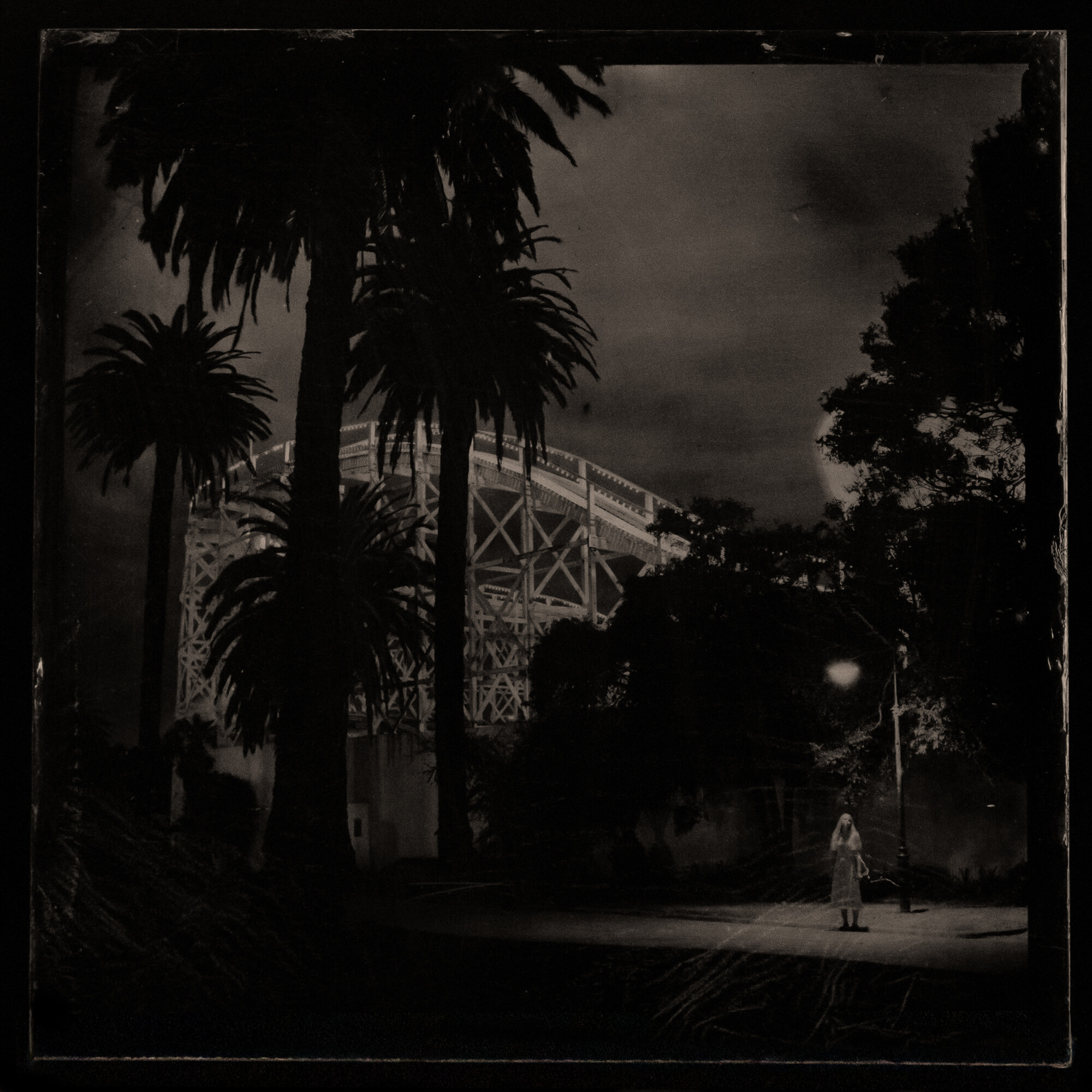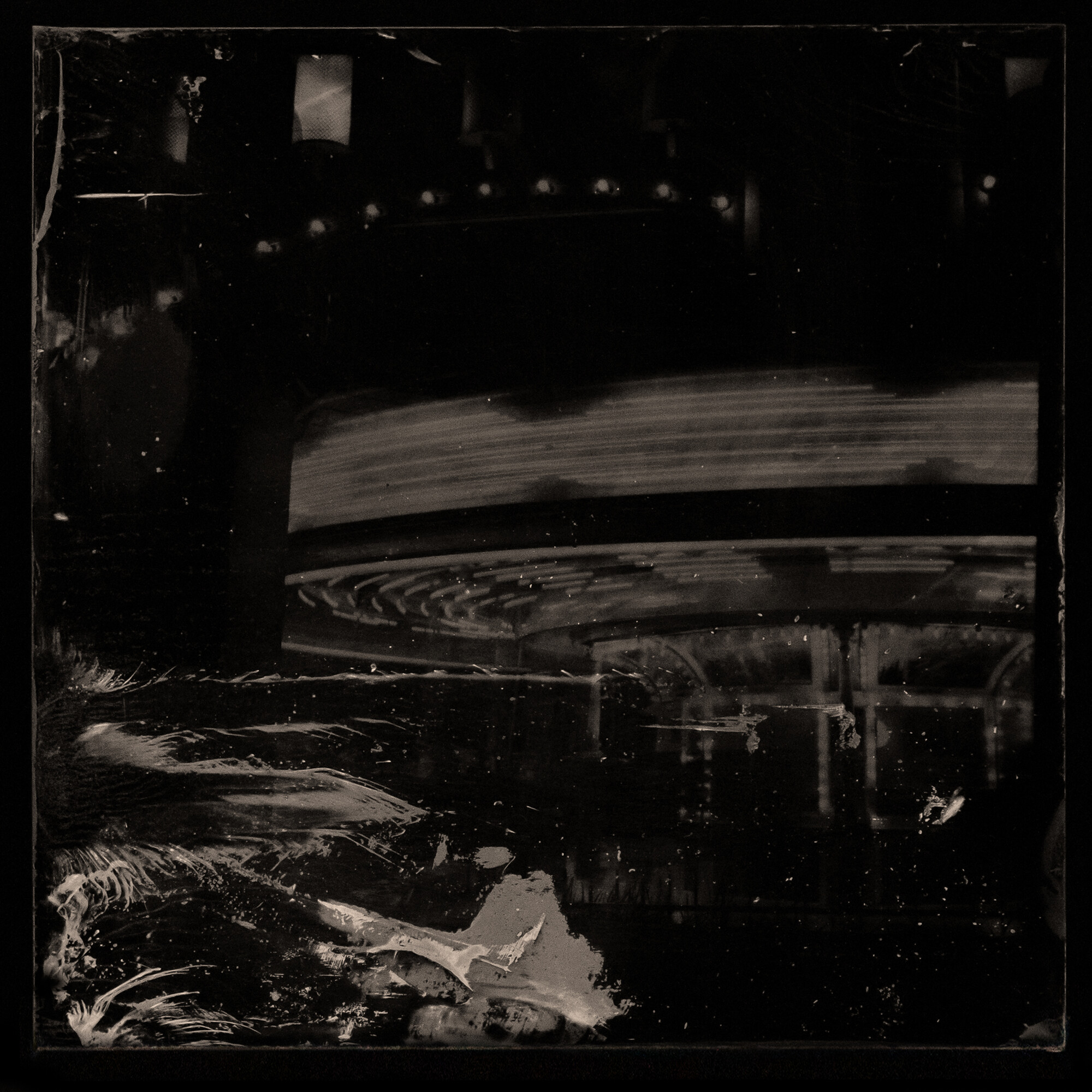Jane Burton, Kingdom of Pleasure
Ursula Cornelia de Leeuw
Jane Burton’s introductory statement to her exhibition of stunning, tenebrous ambrotypes, Kingdom of Pleasure, perfectly prepares the viewer for their voyage through the fog of photographic memory to the hazy, coastal gothic foreshore of St Kilda’s Luna Park. Burton describes her first encounter with the festive centre:
As a child from the country, I encountered it as a phantasmagorical realm rising through briny sea fog, fringed by exotic palm trees. Upon entering through the great, devouring mouth, as if into an Underworld; shrieks and clatter emanating from the Scenic Railway drifted on the salty night air.
Appropriately exhibited a few streets away in the Acland Street project space of Linden New Art, Burton’s show consists of thirteen ambrotypes—-an appropriate number considering the bewitched atmosphere of each self-described “night-dream”. This mood is enhanced by the high contrast black-and-white exposure of each image, titled simply by number, complimented by the equally dark frames that encase them. The install sensitively uses lighting necessary to accommodate the glossy surfaces without any blow-out, while also giving the viewer a sneaky reflection of themselves. Some photographs are paired, creating a sense of “doubling”. This is just one of the gothic tropes (think Dr. Jekyll and Mr. Hyde) present in the exhibition, which explore themes of childhood and the carnivalesque within an undeniably spectral environment. This presence is palpable in the night scene of ambrotypes #4 and #5 that depict, at a distance, a pale girl standing beneath a lamppost’s glow. The scene is backdropped by Luna Park’s scenic railway, a ghostly apparition foregrounded by the darkened silhouettes of St Kilda’s palm trees.


Kingdom of Pleasure follows the general thrust of Burton’s oeuvre in its macabre, other-worldly style, achieved through high-contrast photographic methods. In her 2021 exhibition Night Windows at the Monash Gallery of Art, Burton followed in the path of the highly influential documentary photographer Eugène Atget by capturing a series of shopfronts, here cast in the ominous shadow of pandemic nights. This is carried in Kingdom of Pleasure, particularly in the desolate carriageways of #6 and #7 that recall Atget’s empty, Parisian cityscapes that were later discovered and compiled for publication by Berenice Abbott in the 1920s to a Surrealist reception.
Burton’s earlier photographic series A Temptation to Ships (2018) and Ivy (2009) are more posed, at times bordering on the kind of eldritch twee reminiscent of an inspired schoolgirl, filled with the gothic angst of adolescence. My allusion to youthful naivety here is not intended to disparage but gesture toward the beauty of the teenage cultivation of style that so often emerges from encounters with heavy-handed fashions or genres. This is an expression that many creative minds first incept in their school years with a keen, saccharine flavour. Elements of this mood are evident in Burton’s more recent series, A Phantom Lover (2020), combined with the more advanced effects of technical experimentation, such as double exposure, that create a more sophisticated ambience similar to Kingdom of Pleasure’s ambrotypes. This series also echoes motifs of voyeurism and sensuality from the earlier I did it for you (2005), loosely based on the contemporaneous Maria Korp murder of 2005. Here, the C-type prints that depict feminine spectres behind delicate, lace curtains are exquisitely exposed in black-and-white, expressing a morbidly thrilling narrative of hysteria, jealousy, murder and euthanasia.
A brilliant historical predecessor to this sensibility is Francesca Woodman’s photography from the 1970s. With an updated feel of Julia Margaret Cameron’s fantastical, nineteenth century pictorialism, or perhaps Lady Clementina Hawarden’s albumen prints, Woodman’s photographs consist of many eerie, blurry self-portraits in old dilapidated and empty rooms, often taken in the nude or dressed in girlish costume. Her use of long shutter speeds and double exposure allow the photographs to take on the quality of a spiritual possession or haunting angelic vision. For example, Woodman’s Houses series from 1975 to 1978, particularly house #3 and #4, exhibit an uncanny domesticity and melancholic femininity. From Woodman’s more contemporary echo of the nineteenth-century gothic, we can perhaps better understand the birth of Burton’s own moonstruck style.


Another obvious stylistic predecessor to Burton’s series is Surrealism. Think the avant-garde writer Louis Aragon, who penned ‘Nightwalker/The Paris Peasant’(1926), or photographers Brassaï, Eli Lotar, Ilse Bing and Germaine Krull, to name only an elite few. They saw a city transformed through a kind of visual intoxication, an uncovering of modernity’s unconscious through the technological reproduction of its most everyday sites. Rather than understand photography as a mere reflection of reality as it appears to human perception—-as was the myth of early photography and the dominance of portraiture—-the Surrealists approached the photograph as an unveiling of the desirous forces and histories at play in everyday life, beyond the capabilities of the naked eye. In this sense, the photograph is the “true”, transformative reflection of a reality that otherwise remains unseen. The Surrealist penchant has been carried by contemporary Australian photographers like Pat Brassington, who operate in the more mainstream sensibility of Man Ray’s heavy-handed, studio eroticism. Burton’s photographs in Kingdom of Pleasure evoke a different Surrealist interest in topographical studies and the optical unconscious of the site. Moreover, in Surrealism, there is a sense of the nineteenth-century gothic: the period where literature awoke to modernity and its supernatural subconscious. As the two converge in Burton’s photographs, the gothic is a natural stylistic accompaniment to the unhallowed arts of Surrealist reproductive technology. However, the influences cited in the exhibition text are not based in form or even style but in the continuation of the subject matter itself.
Noted in the exhibition text are the painterly depictions of Luna Park by Sidney Nolan and Albert Tucker. Nolan’s 1941 abstraction of the Big Dipper sees it condensed into a flat outline of intersecting grids and geometries, coloured in his signature child-like style is a nod to Cubism. Tucker’s 1945 Luna Park, and later 1988 Extinction Express, is also painted with a cartoonish flavour, this time imbued with the grotesque qualities of a dark nursery rhyme, or a nightmare of decadence and moral decline. What links these painterly studies of Luna Park to Burton’s photographs is the necessity to return to childhood as one passes through its grinning archway. Pertinent to Burton’s stylistic affectation is the more sinister enchantment of childhood perception, or one’s memory of it, that has the increased capacity to see things anew. Continuing in the vein of Tucker, this is a way of seeing that is more open to wonder but also terror, indulgence and unnameable excess. The tone is reminiscent of the postmodern gothic of English writer Angela Carter and the disturbing combination of fairy-tale and eros found in ‘The Magic Toyshop’(1967) and ‘Nights at the Circus’ (1984). Suggested in these scenes is also a state of deep intoxication, perhaps one of the only paths to childhood vision available to the backwards adult.
As Charles Baudelaire says in ‘The Painter of Modern Life’ (1863): “The child sees everything as a novelty; the child is always ‘drunk’”. To compare a vision of recurring novelty with the sensation of drunkenness is to say that during a state of deep intoxication, every encounter is born again; everything takes on the fetish wonder of being new and invigorated with the manic intrigue of a child. Baudelaire continues: “Nothing is more like what we call inspiration than the joy the child feels in drinking in shape and colour”. The mind of the child, drunk off appearances to the point of over-stimulation, embodies the moment perception takes flight to inspiration. Baudelaire then takes a turn, linking with the plague-like pallor of Burton’s empty theme park, by comparing childhood perception to a state of convalescence: “The convalescent, like the child, enjoys to the highest degree the faculty of taking a lively interest in things, even the most trivial in appearance”. In Burton’s shadow-drenched ambrotypes, one certainly feels a sense of Baudelaire’s “transformative impressions” that occur after a state of physical sickness. Upon awakening to a heightened state of intrigue, the pleasures of sight revivify a well-trodden place, even if that means uncovering its perversions.

While this review has explored the possible genealogical, thematic and stylistic qualities of Burton’s Kingdom of Pleasure, it is necessary to emphasise its technical form. It is the ambrotype technique itself that brings Burton’s transformative intoxication to light. This is made clear in #10, where the image on the surface of the glass has been obscured by a large fluid marking; a resulting “error” of the wet plate process. It is in moments like these, where bubbles formed as chemicals peel away, that the viewer is deliberately made aware of Burton’s alchemical process as a tool that is indispensable to her style. In the necessity of its high contrast, inky depths, combined with the oracular gleam of its shiny surface, the ambrotype perfectly lends itself to Burton’s subject where the viewer travels in a Surrealist, gothic fashion to both transform and inebriate perception. In Kingdom of Pleasure, Burton journeys to a place of stylised regression and pensive wonder, at once pathologising the historic Luna Park while also seeing it anew.
Ursula Cornelia de Leeuw is a writer and researcher between Melbourne and Adelaide.


